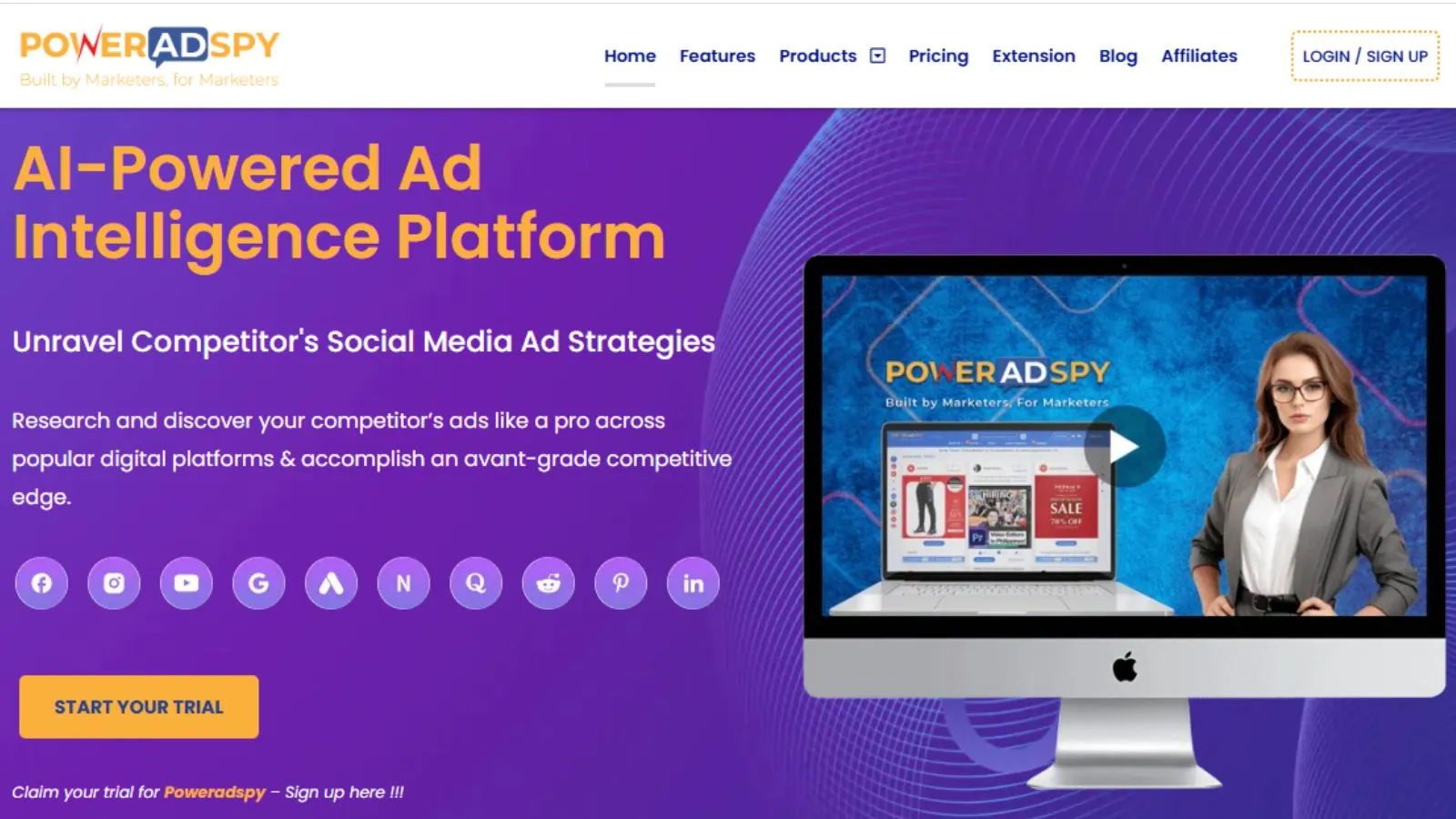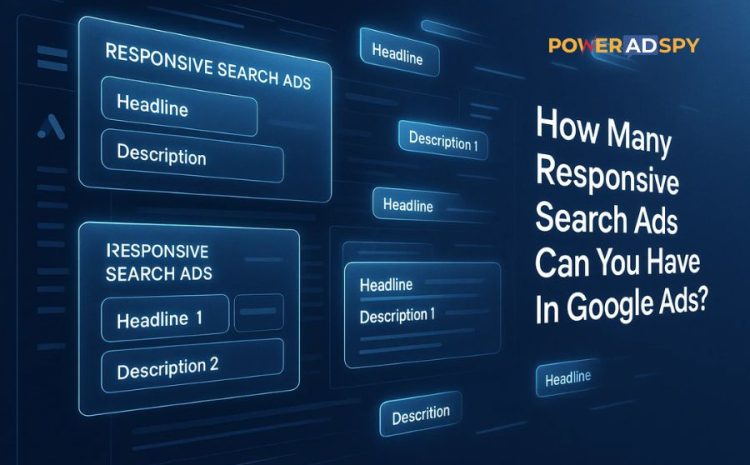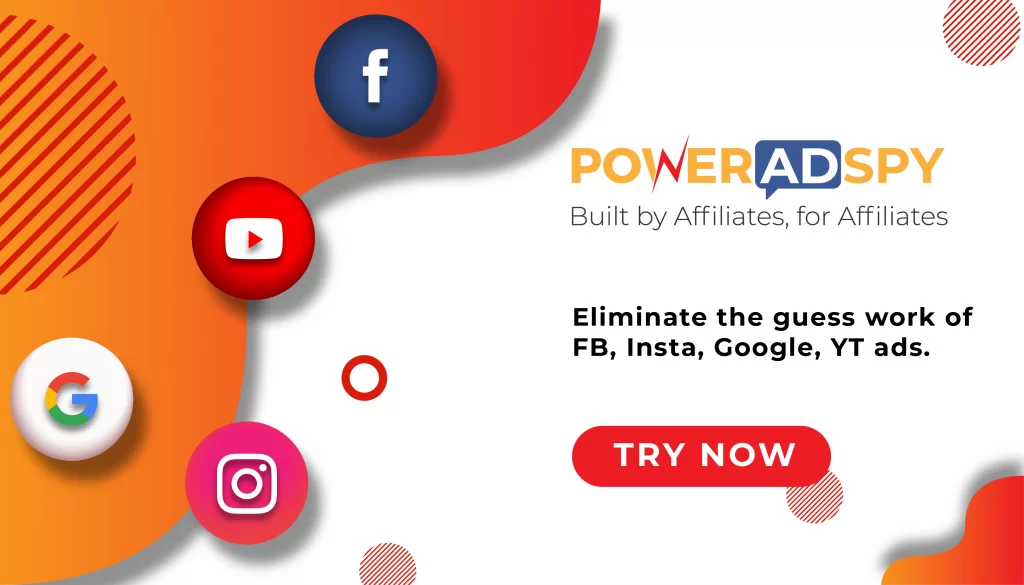How Many Responsive Search Ads Can You Have In Google Ads?
If you’ve ever wondered, “How many responsive search ads can you have in Google Ads?” you’re not alone.
As Google continues to push automation and machine learning in advertising, responsive search ads (RSAs) have become a key part of every marketer’s strategy.
But with new ad formats come new rules, and understanding those limits is crucial to making the most of your campaigns.
Over the years, Google search ads have evolved significantly, from basic text ads with fixed messaging to dynamic, AI-powered formats that test multiple headlines and descriptions in real time.
Responsive search ads represent the next generation, helping advertisers reach users with the most relevant message based on their intent and search behavior.
In this blog, we’ll explore how many RSAs you can use, why that number matters, and how you can use this format to your advantage.
Whether you’re just getting started or looking to refine your strategy, this guide will help you stay ahead in the competitive world of Google Ads.
Listen Podcast Now!
What Are Google Responsive Search Ads?
Google responsive search ads are a flexible ad format designed to help you reach more potential customers with tailored messaging.
Instead of writing a single static ad, you can input up to 15 different headlines and 4 descriptions.
Google then automatically tests different combinations to find what performs best for each user search query.
This format allows for greater ad variation and helps improve click-through rates by showing more relevant ads.
Over time, the system learns which headline-description pairings resonate most with your audience, which ultimately boosts your campaign’s performance.
Many advertisers wonder: How many responsive search ads can you have in Google Ads?
The current limit is three RSAs per ad group.
This gives you enough room to test different themes, CTAs, or keyword placements while still keeping your campaign organized and manageable.
With Google Responsive Search Ads, the emphasis is on automation and personalization.
You provide the building blocks, and Google does the work of mixing and matching them for the best results.
It’s a smarter, more adaptive way to advertise, especially if you’re targeting multiple customer segments or testing new messaging strategies.
How Many Responsive Search Ads Can You Have Per Ad Group?
The Straightforward Answer:
One of the most frequently asked questions by advertisers is:
How many responsive search ads can you have in Google Ads?
The answer is clear:
You can have up to three responsive search ads (RSAs) per ad group.
Google sets this limit to help advertisers test various messages efficiently while maintaining clarity in performance tracking.
Why Google Allows Only 3 RSAs:
This limit isn’t random. Here’s why it matters:
- Keeps ad testing focused – With three ads, you can test different tones and messages without overwhelming the algorithm.
- Improves optimization – Google’s machine learning performs better when it has a manageable number of variations to test.
- Prevents ad fatigue – Fewer ads per group ensure each variation gets sufficient impressions and data.
What Goes Into a Responsive Search Ad?
Each RSA offers generous space to experiment with your messaging:
- Up to 15 different headlines
- Up to 4 unique descriptions
- Google automatically mixes and matches these elements to show the best-performing combinations based on user queries.
Best Practices for Using Multiple RSAs:
While you’re allowed three RSAs, quality matters more than quantity. Here’s how to make the most of them:
- Differentiate your message:
Avoid using the same or very similar text across all three ads. Instead, provide distinct messaging for each RSA:
- Highlight product benefits: Showcase what makes your product or service valuable to the customer.
- Create urgency: Focus on time-sensitive offers or limited-time promotions to encourage quick action.
- Build trust: Emphasize credibility through customer testimonials, awards, or industry recognition.
- Test diverse CTAs and keyword placements.
- Monitor ad strength and Google recommendations on a regular basis.
Strategic Takeaway:
Understanding how many responsive search ads can you have in Google Ads? is more than just knowing a number.
It’s about how you use that space. Relying on a single RSA limits your ability to test what resonates with your audience.
Using all three, however, expands your opportunities to improve ad performance and conversion rates.
So, make each RSA count. Vary your copy, align it with campaign goals, and let Google optimize the rest.
Understanding Google Dynamic Search Ads Vs. Responsive Search Ads:
When planning your campaign strategy in Google Ads, it’s essential to understand the difference between Google dynamic search ads and responsive search ads (RSAs).
Both offer automation benefits but work in distinct ways.
1. What Are Google Dynamic Search Ads?
- Automated headlines and landing pages: Google scans your website and dynamically generates ad content based on user search queries.
- Best for large websites: Ideal for Business Goals with an extensive product catalog or content-rich websites.
- Minimal manual effort: You don’t need to provide multiple headlines or keywords — Google handles it.
- Limited control: Since Google creates the content, you can’t control exactly what the ad will say, which may affect brand tone or message clarity.
2. What Are Responsive Search Ads?
- More customization and control: You input up to 15 headlines and 4 descriptions; Google automatically tests combinations.
- Powered by machine learning: Over time, Google identifies which combinations perform best and optimizes delivery.
- Better for performance testing: Ideal if you want to A/B test messaging, offers, or calls-to-action while still using automation.
3. Which One Should You Choose?
A key question many advertisers ask is:
How many responsive search ads can you have in Google Ads?
You can create up to three RSAs per ad group.
This allows room to test different messaging strategies while staying within Google’s ad structure.
Use Google dynamic search ads when you want broad coverage with minimal setup, and choose RSAs when you want to guide the message with strategic input.
Both have their place; it’s all about your campaign goals.
Why You Should Monitor Competitor Strategies?
Monitoring your competitors’ ad strategies is no longer a luxury; it’s a smart necessity.
Here’s why keeping a close watch on what others are doing in the Google Ads space can give you a sharp competitive edge:
-
Uncover What’s Working in Your Niche:
Studying competitor ad patterns helps you identify the kind of messaging, offers, and visuals that are resonating with your shared audience.
This insight helps shape more relevant and click-worthy ads for your brand.
-
Strategic Use of Responsive Search Ads:
If you’re wondering, how many responsive search ads can you have in Google Ads?
The short answer is three per ad group.
But the more valuable question is: how are your competitors using those three opportunities?
Observing how they structure headlines, pin key messages, and combine descriptions helps you refine your approach.
-
Learn Without Trial-and-Error:
Instead of relying solely on A/B testing or guesswork, competitor research saves time. You can study proven ad formats and styles that are already performing well, and adapt them for your own goals.
-
Use the Right Tools to Spy Ethically:
Curious about how to spy on competitors’ Google Search Ads without crossing any lines?
Tools like ad intelligence platforms allow you to ethically view competitors’ live ads, top-performing headlines, CTA patterns, and more, all legally and transparently.
Want to know how to spy on competitors Google Search Ads without overstepping boundaries?
The right tools make it easy, ethical, and incredibly insightful.
-
Stay Ahead in a Competitive Market:
With trends and algorithms changing constantly, competitive insights help you stay agile.
You’ll not only avoid repeating what’s already out there, you’ll also discover unique angles and missed opportunities to stand out.
By making competitor tracking part of your regular strategy, you empower your campaigns with direction, data, and real-world context.
Also Read:
How To Use Business Goals Template in 2025?
What is a Marketing Technology Stack
How PowerAdSpy Can Help You With Competitive Ad Intelligence?

PowerAdSpy offers more than just ad tracking; it gives you a behind-the-scenes look at what top brands are doing to win clicks and conversions.
With its robust search and filtering tools, you can uncover high-performing ad creatives, study competitors’ messaging, and analyze audience responses, all in one place.
Whether you’re running responsive search ads or exploring new keyword angles, PowerAdSpy makes competitive research smarter and more actionable.
Key Features of PowerAdSpy:
- Competitor Ad Intelligence – Uncover your competitors’ ad strategies across Google and multiple other platforms.
- Ad Copy Analysis – Explore real ad headlines, descriptions, and call-to-actions used in high-performing campaigns.
- Search by Keyword, Domain, or CTA – Easily filter ads based on the criteria that matter most to your business.
- Engagement Metrics – See which ads are generating the most user engagement, like clicks, shares, and comments.
- Multi-Network Compatibility – Spy on ads running not just on Google, but also on Facebook, Instagram, YouTube, and more.
- Ad Bookmarking – Save and organize compelling ad examples for future reference or inspiration.
- Geo & Demographic Filters – Analyze ad campaigns based on targeted regions or specific audience demographics.
- Landing Page Preview – View the destination pages behind ads to understand the full marketing funnel.
Tips To Optimize Your Responsive Search Ads:
To get the most out of your responsive search ads, variety and structure are key.
Start by writing at least 10 unique headlines and four distinct descriptions. Make sure each headline highlights a different feature, benefit, or call to action.
This helps Google test multiple combinations to find what works best.
Pin important headlines to specific positions, especially if you have a key message or offer that should always show up.
Regularly monitor ad strength suggestions and make tweaks based on Google’s recommendations.
Wondering how many responsive search ads can you have in Google Ads?
You can create up to three RSAs per ad group, which gives you more room to experiment with messaging, tone, and CTA styles without breaking campaign structure.
Also, don’t forget to use your top-performing keywords naturally in your headlines and descriptions.
Over time, test which combinations drive the most conversions.
The more variety you give the algorithm, the better it can match your ad to the right audience at the right time.
Conclusion:
If you’re serious about improving your ad performance, responsive search ads are no longer optional; they’re essential.
With Google’s machine learning capabilities, they give you the flexibility to test multiple headlines and descriptions at once, helping you discover what truly connects with your audience.
So, how many responsive search ads can you have in Google Ads?
The answer is up to three per ad group. But it’s not just about hitting the limit.
It’s about making each ad count by using diverse messaging, strong CTAs, and strategic keyword placements.
Keep experimenting, reviewing performance insights, and refining your ad combinations. \
And if you want a competitive edge, don’t forget to monitor what’s working for others in your niche using the right ad intelligence tools.
The smarter your strategy, the stronger your ROI.
FAQs:
Q1. How many responsive search ads can you have in Google Ads?
You can have up to 3 responsive search ads per ad group in Google Ads.
This gives you flexibility to test different headlines and descriptions, while Google automatically optimizes which combinations perform best.
Q2. Are responsive search ads better than expanded text ads?
In many cases, yes. RSAs use machine learning to deliver the most relevant message to each user, which can improve CTR and conversions over time.
Q3. Can I still run my old expanded text ads?
Yes, previously created expanded text ads will continue to run, and you can view their performance. However, you can no longer create new ones.
Q4. What’s the ideal number of headlines for RSAs?
Google allows up to 15 headlines, but it’s recommended to use at least 8–10 varied and keyword-rich headlines to give the algorithm enough data to optimize.
Q5. How can I improve the performance of RSAs?
Focus on strong, diverse headlines, use keyword variations, avoid repetition, and check the “ad strength” indicator regularly to make necessary improvements.











